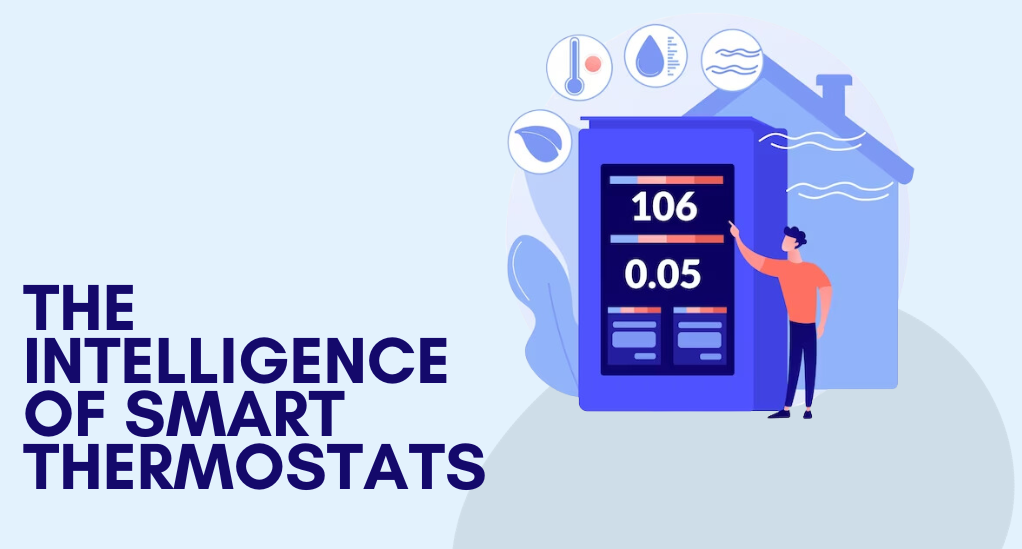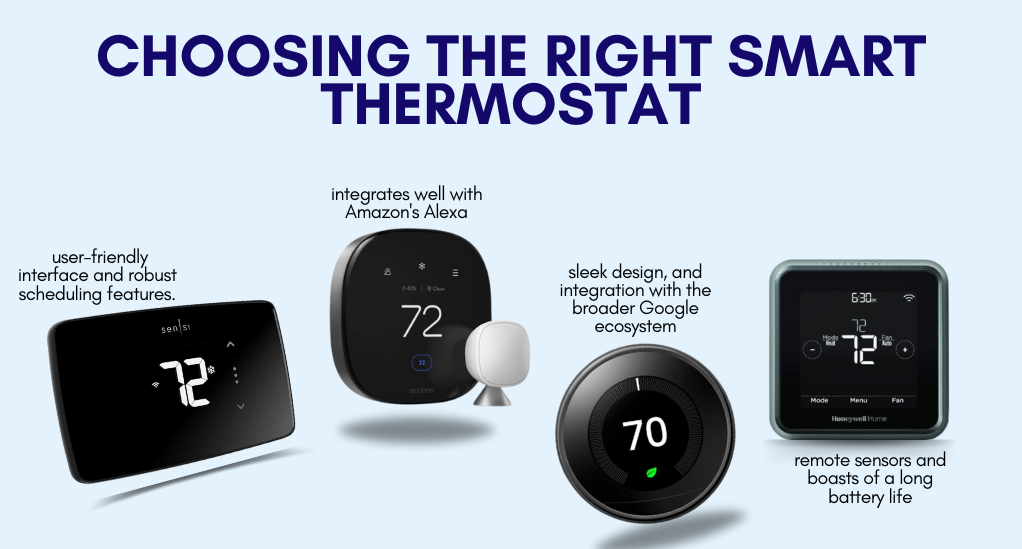
How to Optimize Energy Consumption with Smart Thermostats
In today’s rapidly evolving technological landscape, the way we interact with our homes is undergoing a significant transformation. At the forefront of this revolution is the smart thermostat—a device that promises not only to enhance our comfort but also to optimize our energy consumption. As global energy demands soar and environmental concerns become more pressing, the need for efficient energy solutions has never been greater. Enter the world of smart thermostats, where innovation meets conservation.
The Rise of Smart Thermostats
The concept of regulating indoor temperatures is not new. For decades, traditional thermostats have allowed homeowners to set desired temperatures manually. However, as technology advanced, so did the capabilities of these devices. Programmable thermostats, which allowed users to schedule temperature changes throughout the day, were a step forward but came with their own set of challenges. Many users found them complex to program, leading to suboptimal energy usage.
Smart thermostats emerged as a solution to these challenges. These devices, equipped with sensors, Wi-Fi connectivity, and advanced algorithms, offer a more intuitive and efficient approach to temperature regulation. They can learn from users’ behaviors, adjust to external factors like weather, and even be controlled remotely via smartphones or computers.

The Imperative of Energy Optimization
According to the U.S. Energy Information Administration, heating and cooling account for nearly half of a typical U.S. home’s energy use. This statistic underscores the immense potential for energy savings if we can optimize how we heat and cool our homes. With energy prices on the rise and the pressing need to reduce carbon footprints, the significance of efficient energy use cannot be overstated.
| Energy Consumption in U.S. Homes | |
|---|---|
| Activity | Percentage of Total Energy Use |
| Heating & Cooling | 48% |
| Water Heating | 14% |
| Appliances & Electronics | 24% |
| Lighting | 6% |
| Other | 8% |
Source: U.S. Energy Information Administration
In this context, smart thermostats are not just a luxury or a convenience—they are a necessity for a sustainable future. By intelligently adjusting temperatures based on real-time data and user preferences, these devices can significantly reduce energy wastage, leading to both environmental benefits and cost savings for homeowners.
As we delve deeper into the world of smart thermostats in the sections that follow, we’ll explore their features, benefits, and the transformative impact they can have on our daily lives and the planet.
Understanding Smart Thermostats
The thermostat, a household staple, has undergone significant evolution over the years. From the rudimentary dials of yesteryears to the digital displays of the modern era, the journey has been marked by innovation. But what exactly sets smart thermostats apart from their predecessors?
What Makes a Thermostat “Smart”?
At its core, a smart thermostat offers more than just temperature control. It’s an amalgamation of sensors, algorithms, and connectivity features that work in tandem to provide an enhanced user experience. Here are some defining characteristics:
- Learning Capabilities: Unlike traditional models that require manual adjustments, smart thermostats learn from user behaviors over time. For instance, if you consistently lower the temperature at night, the device will start doing it automatically.
- Remote Control: With Wi-Fi connectivity, users can adjust settings from anywhere using a smartphone, tablet, or computer. Heading home early from work? Set the temperature to your liking before you even step through the door.
- Energy Usage Reports: Many smart thermostats provide detailed energy consumption reports, allowing users to understand their usage patterns and make informed decisions.
- Integration with Other Smart Devices: These thermostats can often be integrated with other smart home devices, such as lights or security systems, for a cohesive home automation experience.
The Evolution from Manual to Programmable to Smart
To appreciate the value of smart thermostats, it’s essential to look at the broader timeline:
- Manual Thermostats: The earliest models, where users set the temperature by turning a dial or moving a lever. While simple, they lacked precision and flexibility.
- Programmable Thermostats: Introduced in the late 20th century, these allowed users to set schedules for temperature changes. However, their interface was often clunky, and many users found them challenging to program effectively.
- Smart Thermostats: The latest in the line, these devices combine the best of their predecessors with modern technology. They offer the scheduling abilities of programmable thermostats but with the added benefits of learning, remote control, and integration.
The transition from manual to smart thermostats represents not just technological advancement but a shift towards a more sustainable and user-centric approach to home comfort.
The Power of Connectivity
In the age of the Internet of Things (IoT), connectivity is king. Smart thermostats epitomize this trend, leveraging the power of the internet to offer features that were once deemed futuristic.
How Wi-Fi Connectivity Enhances Thermostat Functionality
Wi-Fi isn’t just for browsing the web or streaming videos. In the context of smart thermostats, it serves as the backbone for many of their advanced features:
- Real-time Adjustments: Whether you’re on vacation or at the office, Wi-Fi connectivity allows you to control your home’s temperature in real-time, ensuring optimal comfort and energy efficiency.
- Software Updates: Just like your smartphone, smart thermostats receive periodic software updates. These updates can introduce new features, improve performance, or fix bugs, ensuring your device remains at the cutting edge.
- Integration with Virtual Assistants: Many smart thermostats can be controlled using voice commands through virtual assistants like Amazon’s Alexa, Google Assistant, or Apple’s Siri. This hands-free control adds a layer of convenience to the user experience.
Remote Access and Control
One of the standout features of smart thermostats is the ability to control them remotely. Using dedicated apps or web interfaces, users can:
- Adjust Temperature Settings: Whether you want to increase the heat on a chilly day or cool things down during a heatwave, you have complete control at your fingertips.
- View Energy Consumption: Many apps provide detailed insights into energy usage, helping users identify patterns and areas for improvement.
- Set Schedules: While on the go, users can set or modify schedules, ensuring their home is always at the desired temperature.
The era of connectivity has redefined our interaction with everyday devices. In the realm of home automation, smart thermostats stand as a testament to the potential of connected technology.
Learning and Adapting: The Intelligence of Smart Thermostats

The true essence of a smart thermostat lies in its ability to learn and adapt. Unlike traditional devices that rely solely on user input, these modern marvels use a combination of sensors and algorithms to optimize temperature settings based on various factors.
How Smart Thermostats Learn from User Behaviors
Every household has its unique rhythm. Some families might prefer warmer temperatures in the early morning, while others might opt for cooler settings during the night. Recognizing these patterns is where smart thermostats shine:
- Adaptive Algorithms: Over time, the device observes when and how you adjust the temperature. Using this data, it begins to make these adjustments on its own, ensuring consistent comfort without manual intervention.
- Presence Detection: Using built-in motion sensors, smart thermostats can detect when someone is at home. If the house is empty, the device might adjust the temperature to save energy, reverting to the preferred setting when it senses someone’s return.
- External Factors: Some advanced models consider external factors like weather forecasts. If a cold front is approaching, the thermostat might preemptively warm the house.
The Role of Sensors in Smart Thermostats
Sensors are the unsung heroes in the world of smart thermostats. They continuously gather data, which the device uses to make informed decisions:
- Temperature Sensors: These measure the current temperature, ensuring the heating or cooling system activates at the right time.
- Humidity Sensors: By monitoring humidity levels, the thermostat can work in tandem with humidifiers or dehumidifiers to maintain optimal indoor air quality.
- Occupancy Sensors: These detect movement or presence in a room, allowing the device to adjust settings based on occupancy.
- Ambient Light Sensors: Some models can adjust their display brightness based on the ambient light, ensuring they’re not too bright at night or too dim during the day.
Geofencing: The Future of Thermostat Technology
Geofencing is a technology that uses a device’s GPS to determine its location. In the context of smart thermostats, it offers a new dimension of automation and energy savings.
Understanding Geofencing and Its Benefits
Imagine your thermostat knowing when you’re about to reach home and adjusting the temperature accordingly. That’s the power of geofencing:
- Dynamic Adjustments: By setting a virtual boundary around your home, the thermostat can detect when you enter or leave this boundary. If you’re leaving the office and heading home, the device can start warming or cooling your house, ensuring it’s at the perfect temperature upon your arrival.
- Energy Savings: If the thermostat detects that all family members have left the geofenced area, it can switch to an energy-saving mode, reducing unnecessary heating or cooling.
- Integration with Other Devices: Geofencing isn’t limited to thermostats. It can integrate with other smart home devices. For instance, as you approach home, not only can the temperature be adjusted, but the lights can turn on, and your favorite music can start playing.
Addressing the Flaws of Programmable Thermostats
While programmable thermostats were a significant leap from manual ones, they weren’t without their shortcomings. Smart thermostats have been designed to address many of these issues.
Challenges with Traditional Programmable Thermostats
- Complex Programming: Many users found programmable thermostats cumbersome to set up. Missing a step or making an error in programming could lead to discomfort and energy wastage.
- Lack of Flexibility: These devices operated strictly based on the set schedule. If there was a sudden change in plans, like an unplanned day at home, the thermostat wouldn’t adjust unless manually intervened.
- No Remote Access: Without connectivity features, users couldn’t adjust settings when away from home.
How Smart Thermostats Overcome These Challenges
- Intuitive Interfaces: Modern smart thermostats come with user-friendly interfaces, be it touchscreens or companion apps, making setup and adjustments a breeze.
- Learning and Adaptation: As discussed earlier, smart thermostats learn from user behaviors, reducing the need for complex programming.
- Connectivity: With Wi-Fi and smartphone integration, users have control over their thermostats from anywhere, offering unparalleled flexibility.
In the journey of thermostat evolution, smart thermostats represent a culmination of lessons learned from the past, combined with the technological advancements of the present.
Real-world Energy Savings with Smart Thermostats
One of the primary motivations for homeowners to invest in smart thermostats is the potential for tangible energy savings. But how do these devices fare in real-world scenarios?
Studies Showcasing the Energy-Saving Potential
Several independent studies and research have been conducted to gauge the effectiveness of smart thermostats in reducing energy consumption:
- Nest Learning Thermostat Study: According to a study by Nest, households saved an average of 10-12% on heating and 15% on cooling, translating to an estimated average savings of $131 to $145 a year.
- Ecobee Savings Report: Ecobee claims that users can save up to 23% on heating and cooling costs annually, based on a study comparing energy usage with a hold of 72°F.
- Utility Company Incentives: Many utility companies, recognizing the potential of smart thermostats, offer rebates or incentives to customers who install them. These incentives not only reduce the upfront cost of the device but also underscore the broader energy-saving potential recognized by energy providers.
Comparing Energy Consumption: Manual vs. Programmable vs. Smart
To truly understand the benefits of smart thermostats, it’s essential to compare them with their predecessors:
| Type of Thermostat | Average Annual Energy Savings |
|---|---|
| Manual | 0% (Baseline) |
| Programmable | 5-10% |
| Smart | 10-23% |
Note: The above percentages are approximate and can vary based on usage patterns, the specific model of the thermostat, and external factors like weather.
The Broader Impact on the Electrical Grid
Beyond individual households, smart thermostats have the potential to influence the broader electrical grid positively:
- Demand Response Programs: Some utility companies have programs where they can adjust smart thermostat settings during peak demand periods, helping to stabilize the grid. Participants in these programs often receive financial incentives.
- Reduced Peak Demand: By optimizing energy usage across numerous households, smart thermostats can reduce the overall peak demand on the electrical grid, leading to fewer blackouts and more stable energy prices.
Choosing the Right Smart Thermostat for Your Home
With a plethora of options available in the market, selecting the right smart thermostat can seem daunting. However, by considering a few key factors, homeowners can make an informed decision that aligns with their needs.

Factors to Consider
- Compatibility: Ensure that the smart thermostat is compatible with your home’s heating and cooling system.
- Learning Capabilities: Some models can adapt to your schedule over time, while others rely on manual programming.
- Remote Access: A crucial feature for many, ensure the device can be controlled via a smartphone or computer.
- Energy Reports: Opt for models that provide detailed energy consumption reports, offering insights into usage patterns.
- Integration with Other Devices: If you have other smart home devices, consider a thermostat that can seamlessly integrate with them.
Popular Brands and Their Unique Features
- Nest Learning Thermostat: Known for its learning capabilities, sleek design, and integration with the broader Google ecosystem.
- Ecobee SmartThermostat: Features a remote sensor to measure temperature in different rooms and integrates well with Amazon’s Alexa.
- Honeywell Home T9: Comes with remote sensors and boasts of a long battery life, making it a versatile choice for many homes.
- Emerson Sensi Touch: Praised for its user-friendly interface and robust scheduling features.
In the rapidly evolving world of smart home technology, the right smart thermostat can be a game-changer, offering both comfort and significant energy savings.
Broader Impact on the Electrical Grid
The influence of smart thermostats extends beyond individual households. Their collective impact on the broader electrical grid can be profound, paving the way for a more sustainable and efficient energy future.
Grid Stabilization through Smart Thermostats
- Load Shifting: Smart thermostats can be programmed to shift energy-intensive operations to off-peak hours, reducing strain on the grid during peak demand periods.
- Participation in Grid Services: Some advanced thermostats can communicate directly with utility providers, allowing them to make minor adjustments during high-demand scenarios, a process known as demand response. This collaboration helps prevent blackouts and reduces the need for expensive peaking power plants.
- Predictive Maintenance: By analyzing data from numerous households, utility companies can predict potential grid failures or maintenance needs, addressing issues before they escalate.
Environmental Implications
The energy savings achieved through smart thermostats have a direct positive impact on the environment:
- Reduced Carbon Footprint: Lower energy consumption means fewer greenhouse gas emissions, contributing to global efforts to combat climate change.
- Conservation of Resources: Efficient energy use ensures that fewer natural resources are expended in energy production, promoting sustainability.
Conclusion
The advent of smart thermostats represents a significant leap in home automation and energy management. These devices, with their advanced sensors, algorithms, and connectivity features, promise a future where comfort doesn’t come at the expense of sustainability.
As homeowners, the choice to adopt smart thermostats is not just about enhancing comfort or reducing energy bills. It’s a step towards a more sustainable future, where technology and conservation go hand in hand. The potential of these devices to reshape our energy landscape is immense, and as they become more integrated into our daily lives, we can look forward to a world where every home is smart, efficient, and eco-friendly.
In the ever-evolving narrative of home automation, smart thermostats stand as a testament to human ingenuity, offering a glimpse into a future where technology serves both our comfort and the planet’s well-being.


Leave a Reply